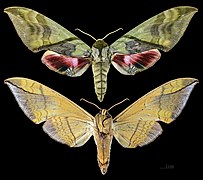Callambulyx
| Callambulyx | ||||||||||
|---|---|---|---|---|---|---|---|---|---|---|

|
||||||||||
| Systematics | ||||||||||
|
||||||||||
| Scientific name | ||||||||||
| Callambulyx | ||||||||||
| Rothschild & Jordan , 1903 |
Callambulyx is a genus from the butterfly family of hawkers (Sphingidae) within the subfamily Smerinthinae .
features
Most species of the genus can be recognized by their receding eye spot on the anal corner of the hind wings. They also have green marbled forewings that are more or less sickle-shaped in the males. The hind wings are carmine red, the thorax and abdomen are green. Both a retinaculum and a frenulum are formed. The proboscis is short and weak and cannot be used for feeding. The pilifer is somewhat enlarged and has bristles. The regressed labial palps are slender. They are larger in the males than in the females, not protruding and not attached to the head. The antennae of the males are flattened ventrally and have long setae . The last segment is long and thread-like. The abdomen has both narrow, spiky and wide scales dorsally . The splints ( tibia ) are not thorny. They are longer than the first tarsal link . The spurs of the front rails are half the length of the rails. The middle and rear rails are very short. The last spur of the rear rail is half as long as the rail is wide. Pulvillus and paronychium are formed, the latter has two lobes on both sides.
The eggs are pale green and ovoid. They are very similar to those of the genus Smerinthus .
The caterpillars also look similar to those of the genus Smerinthus , but have larger tubercles on the follower . The anal horn is erect, slightly curved and granulated.
The pupa again looks similar to those of the genus Smerinthus . The cremaster is elongated and has either a pair of thorns on the top or a few thorns on the sides.
Way of life
The food plants of the caterpillars are largely unknown. Only Callambulyx tatarinovii is known to feed on the elm family (Ulmaceae).
Occurrence and systematics
The distribution area includes the eastern Palearctic and the Orient . One species, Callambulyx tatarinovii , recently expanded its range towards the western Palearctic, near the Kazakh-Chinese border. The following 10 types are known:
- Callambulyx amanda Rothschild & Jordan, 1903
- Callambulyx diehli Brechlin & Kitching, 2012
- Callambulyx junonia (Butler, 1881)
- Callambulyx kitchingi Cadiou, 1996
- Callambulyx poecilus (Rothschild, 1898)
- Callambulyx rubricosa (Walker, 1856
- Callambulyx schintlmeisteri Brechlin, 1997)
- Callambulyx sichangensis Chu & Wang, 1980
- Callambulyx sinjaevi Brechlin, 2000
- Callambulyx tatarinovii (Bremer & Gray, 1853)
supporting documents
Individual evidence
- ↑ a b c d e Sphingidae of the Western Palaearctic. AR Pittaway, accessed December 30, 2012 .
- ^ Ian J. Kitching, Jean-Marie Cadiou: Hawkmoths of the World. An Annotated and Illustrated Revisionary Checklist (Lepidoptera: Sphingidae). Cornell University Press, New York 2000, ISBN 0-8014-3734-2 .
- ^ Sphingidae of the Eastern Palaearctic. AR Pittaway, accessed December 29, 2014 .





